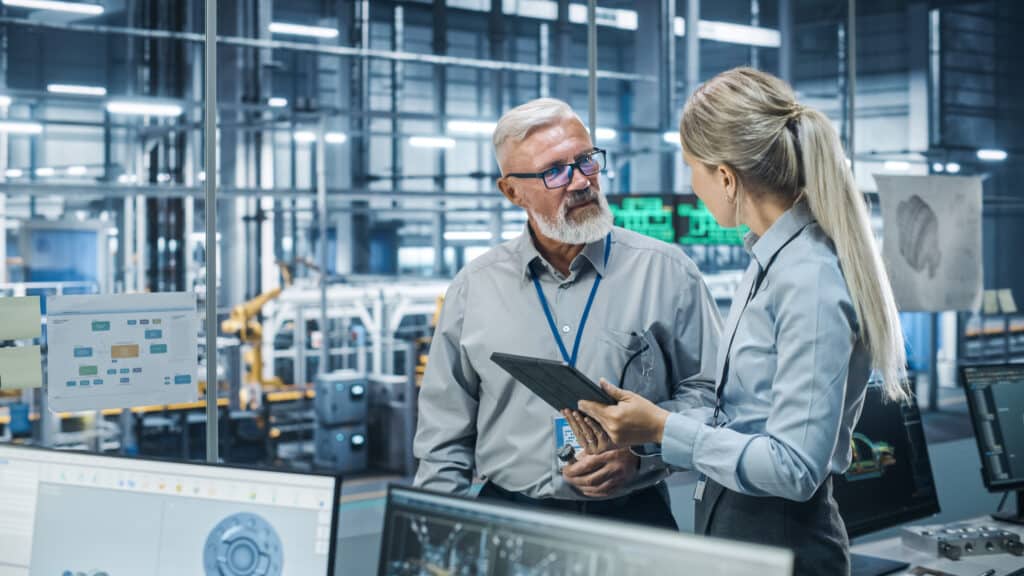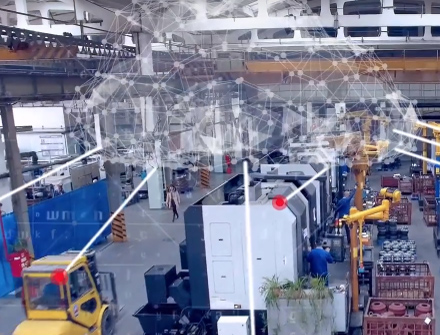The manufacturing sector, like all other industries, is witnessing a paradigm shift. Factories are now becoming more productive and efficient with automation.
Imagine a world where manufacturing processes synchronize with seamless precision. A production line where machines and data work together for better productivity. A system where human intelligence collaborates with cutting-edge technology.
That’s a connected factory for you. It is where AI (Artificial Intelligence) and IoT (Internet of Things) have revolutionized the manufacturing process. Let’s learn how a connected factory works.
Automation in Manufacturing
Traditional Factory Vs. Connected Factory
Traditional factories rely on manual labor to complete their production. They lack the foresight to predict any potential problems, such as operational bottlenecks. Moreover, they often face unexpected delays due to human errors.
The lack of real-time insights and delays often halted the manufacturing process. It also meant that decision-making involved guesswork. As a result, traditional factories faced inefficiencies and higher production costs.
In a connected factory, smart devices and machines connect through IoT. This connectivity enables real-time data exchange, allowing manufacturers to make timely, data-driven decisions.
The result: optimized production. The combination of AI and IoT improves production with better efficiency and intelligence.
IoT in a Connected Factory
IoT is a network of physical devices, sensors, and other objects that connect to the internet. This network can collect and exchange data. In a connected factory, IoT plays a crucial role. It enables seamless communication and data exchange between machines, equipment, and systems.
IoT devices collect real-time data from various sensors on machines and production lines. They then transmit this data over the network. As a result, the manufacturers can track and control processes in real-time.
AI in a Connected Factory
AI refers to the simulation of human intelligence in machines. AI algorithms can analyze vast amounts of data, identify patterns, and make decisions. In a connected factory, AI processes the data from IoT devices to extract valuable insights.
The Power of AI and IoT in Manufacturing
Artificial Intelligence and IoT have become a game-changer for the manufacturing sector. It has the potential to enhance productivity, quality, and efficiency. A study says 86% of manufacturers believe that AI will be essential for their future success.
AI algorithms can:
- Analyze vast amounts of data
- Identify patterns
- Optimize manufacturing processes
With AI in manufacturing, companies gain many benefits, including:
Predictive Maintenance and Minimizing Downtime
AI-driven predictive maintenance enables manufacturers to predict equipment failures before they occur. By analyzing sensor data, AI algorithms can detect early signs of potential issues. This enables maintenance teams to take proactive measures. As a result, there is lesser downtime and operational costs.
Quality Control and Ensuring Perfection
AI-powered quality control systems perform inspections at every stage of the manufacturing process. This real-time analysis and feedback enable manufacturers to follow strict quality standards. This efficient quality assurance minimizes defects and enhances customer satisfaction.
Demand Forecasting and Optimizing Inventory
AI-based demand forecasting models can predict customer demand. It helps manufacturers optimize inventory levels and avoid overstocking or stockouts. This efficient inventory management ensures cost-effectiveness and improved supply chain performance.
Smart Factory Use Cases for Manufacturing in a Connected Factory
Robotics in Manufacturing for Better Efficiency
Robots play a pivotal role in the modern connected factory. They can handle repetitive tasks with more precision and speed. Robots in manufacturing free up human resources for more complex and creative responsibilities. This results in increased production rates and reduced errors.
Data-Driven Decision-Making for Powerful Manufacturers
Connected factories gather a vast amount of data from various sources. These sources include sensors, production lines, and supply chain operations. By analyzing this data using AI algorithms, manufacturers can make timely decisions. This leads to optimizing efficiency and productivity.
Autonomous Vehicles in Warehouses for Efficient Logistics
AI-powered autonomous vehicles are revolutionizing warehouse logistics. These include Automated Guided Vehicles (AGVs) and drones. They can transport goods within the facility, minimizing human effort and time.
AI-Powered Supply Chain Optimization
In a connected factory, AI can optimize the entire supply chain. AI algorithms can identify the most efficient and cost-effective supply chain routes. It does this by analyzing data from suppliers, transportation, and inventory levels. It streamlines the supply chain, reduces lead times, and cuts inventory carrying costs.
Product Design and Optimization with Generative AI
AI-powered generative design allows manufacturers to optimize product designs for performance and efficiency. Generative AI algorithms explore many design possibilities, considering various constraints and objectives.
This leads to innovative and optimized designs. These designs are lighter, stronger, and more cost-effective to produce. It allows manufacturers to innovate their products and stay ahead of the competition.
These use cases show the versatility and potential of AI in manufacturing. It continues to reshape manufacturing processes, leading to a productive and innovative future.
AI Applications for Manufacturing in a Connected Factory
Supply Chain Optimization for Improving Efficiency
AI algorithms can optimize the entire supply chain, from procurement to delivery. By considering various factors, manufacturers can achieve a well-orchestrated supply chain. These factors include demand, lead times, and transportation costs. Taking these factors into account can reduce delays and operational costs.
Energy Management for Embracing Sustainability
Connected factories use AI to optimize energy consumption and reduce environmental impact. AI-driven energy management systems can identify high-energy usage areas and recommend energy-efficient alternatives. This promotes sustainability in manufacturing.
Production Planning and Scheduling
AI can optimize production planning and scheduling in a connected factory. The AI algorithms analyze historical production data, demand trends, and supply chain constraints. It can then develop efficient production schedules. These optimized schedules ensure the effective use of manufacturing resources. As a result, there is a decrease in downtime and an increase in throughput.
Autonomous Material Handling
AI-powered autonomous material handling systems streamline material flow and logistics. Autonomous mobile robots can transport materials and finished goods on the factory floor. These robots can navigate through dynamic environments, avoiding obstacles and optimizing routes. This results in a decrease in manual material handling and enhances operational efficiency.
These applications show that AI integration in manufacturing can revolutionize the whole process. It becomes more efficient, agile, and adaptive to changing demands. As AI continues to grow, we can expect even more innovative applications in the future.
Benefits of AI and IoT in Manufacturing – The Connected Factory Advantage
AI and IoT have revolutionized the manufacturing industry. It has transformed traditional factories into connected hubs of efficiency, intelligence, and innovation. Let’s explore the remarkable advantages of AI and IoT in the connected factory.
Enhanced Operational Efficiency
The combination of AI and IoT leads to a data-driven approach to manufacturing. It allows real-time data collection and analysis. IoT-enabled sensors gather vital information on machine health, energy consumption, and production metrics. AI algorithms process this data to identify inefficiencies, bottlenecks, and areas for improvement.
With actionable insights, manufacturers can optimize workflows, reduce downtime, and improve resource allocation. As a result, there is a significant boost in operational efficiency.
Predictive Maintenance for Reliability
AI algorithms analyze historical performance data and real-time sensor readings from IoT connected factory devices. It can then predict when machinery needs maintenance. This approach helps reduce costly downtime, extend equipment life, and ensure smoother operations.
Predictive maintenance fosters a more dependable manufacturing environment. As a result, there is higher productivity and reduced maintenance costs. Moreover, the production does not face any unforeseen problems due to machines.
Seamless Supply Chain Management
In connected factories, IoT is important for end-to-end visibility across the supply chain. IoT devices track the movement of raw materials and finished goods in real time. This allows manufacturers to track inventory levels, shipment statuses, and logistics efficiency.
With such comprehensive insights, manufacturers can optimize supply chain operations. they can also reduce lead times and enhance customer satisfaction. A streamlined supply chain delivers the right products at the right time. As a result, the company becomes more efficient and strengthens its competitive advantage.
Intelligent Inventory Management
AI and IoT collaborate to revolutionize inventory management in manufacturing. IoT devices track inventory levels, while AI algorithms analyze historical data and trends.
This approach enables manufacturers to predict demand, optimize inventory, and reduce holding costs. By stocking the right amount of inventory, manufacturers can avoid stockouts and overstocking. As a result, there is a significant improvement in the cash flow and reduce in wastage.
Quality Control and Product Optimization
AI and IoT are vital to improving product quality and consistency. IoT sensors check product quality at various stages of production. It also collects data on quality parameters and tolerances. AI-powered quality control systems analyze this data to detect defects and deviations.
Manufacturers can use this data to rectify issues beforehand. This ensures that only high-quality products reach customers. AI-driven product optimization can create designs that enhance performance and reduce material waste.
Conclusion
The connected factory is more than a vision of the future. It is a reality that unfolds before us. As AI and IoT continue to grow in the manufacturing sector, the benefits of automation become increasingly apparent. Now, it’s evident that automation is crucial for manufacturers to remain relevant in this evolving industrial landscape.
In the words of Tim Cook, CEO of Apple Inc., “The factory of the future will have two employees: a man and a dog. The man’s job will be to feed the dog, and the dog’s job will be to prevent the man from touching any of the equipment.” This humorous yet insightful quote captures the essence of automation in manufacturing. It refers to a world where humans and technology collaborate. This will drive innovation, productivity, and a brighter future for the manufacturing industry.











